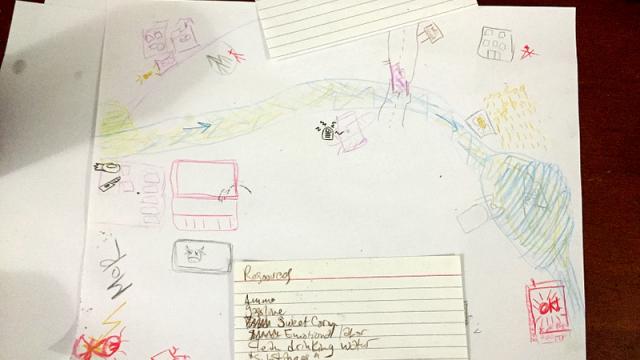On an impossibly hot Friday night, I invited five friends over to play The Quiet Year. If you’ve ever hosted a party before you know how risky this can be — all too often I feel like I’m negotiating between groups of people who don’t quite like each other. But this night was refreshingly harmonious. And it was because of this game.
The Quiet Year is a tabletop game from Buried Without Ceremony about mapmaking and world building. In it, you describe a community that has just experienced an apocalypse of some kind and you then frame the struggles of the year that follows.
The moment I got my hands on this, I wanted to play it, so I emailed everyone who I thought would be interested. They all said yes, and most of them did not know each other, and I also had way too many players for the game. I felt like I had fucked up pretty much right away.
This brings me to the first thing I like about this game: it feels very malleable. Because there were six of us and we didn’t want our turns to take forever, we eased up on some of the actions we needed to take each turn.
In some games, this can absolutely ruin the balance. Here, the game felt noticeably different, but was still a strong framework to hang our story on. This is a GM-less game, so it was hard for any of us to be a rules lawyer. While from time to time we nudged each other to remember certain aspects of the rulebook, we were also just happy to fly by the seat of our pants.
But more importantly, this game where you describe a small community made a small community out of us. The game urges you to build on the ideas of others, and makes sure that the players knows that we’re not in competition. In the rulebook, they tell players to both care about our community and treat ourselves like, “dispassionate scientists conducting an experiment,” and we took it to heart.
While players can take a token that indicates our contempt if we feel like factions we represent aren’t being respected, it always felt jovial and kind to express our mild displeasures in that way. Oh, for a world where contempt is a poker chip!
As we played I could feel us all get enamoured of other people’s ideas. When my seriously cool friend Galen Beebe suggested that perhaps our community had a solid population of people over eighty, her husband, freelance writer and web developer John West, created the character of Chas. He was initially a “healer,” that treated this community of the elderl, and we would all embellish upon this until he became a clueless, exploitative stoner with a shitty ponytail.
When Ayla established a cult centered around butchness, I created in opposition to that a community of emo boys who’d raided a shipment of Alternative Press Magazines and gleaned their image of masculinity from there. Every time someone had an idea, we were stumbling all over each other to complicate it, and in the end we became more defensive of other people’s ideas than our own. Jeannie and Daniel ended up the most vocal advocates for the Emo Teens, myself for the Butch Cultists. We would created a series of short hands to talk to each other about our map — a vernacular forming as each symbol was added.
By the end, none of us wanted to leave that community. Which is why we’re going back. I think we’re all going to be playing games together now — at least I hope so. Our fractious little factions of emos and olds still need us.

Comments